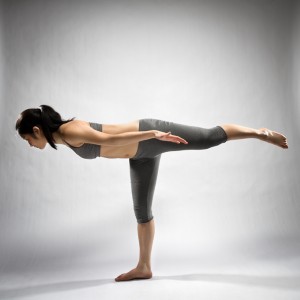I spent two years of my 20s working as a flight attendant. Time long ago erased any memory of where to find the first aid kit on a Boeing 737 and which planes need the girt bar stowed so the emergency slide won’t deploy when the doors open. But every time I travel, I remember this piece of wisdom: if anything is going to go wrong, it almost always happens on taking off and landing.
Yoga poses are a bit like air travel.
Our practice asks us to live in the present and to pay attention to each moment as it unfolds. In contrast, day-to-day life urges us to identify a perfected state and move toward it as quickly as we can. No wonder beginners watch the demonstration, remember only the final shape of the pose, and return to their mats with their minds already halfway down the runway.
But if you rush, you will almost certainly push your body past its ability to hold the alignment of the pose. In a forward bend, your back will round. In a standing pose, your weight will most likely tip forward. Standing or sitting, you will probably drop your pubic bone forward, and lose your connection to your core body.
One yoga lesson that has stayed with me for 20 years came from Israeli teacher Orit Sen-Gupta. Her practice was always a delight to watch, because she moved with such intense yet relaxed concentration.
Orit taught that each pose was a continuum, that every moment, from forming the intent to do the pose, to its fullest expression, to the moment when you returned to your beginning, was an essential part of the pose. No moment was more privileged than any other; no point along the journey was any more “the pose” than any other point.
Especially as beginners, we are much more able to perform actions in the first few points along the continuum of a pose than we are when we reach the limits of our hips and hamstrings and begin to struggle with balance. And the actions we carry forward determine what we achieve in the pose.
Slow down. Resist the temptation for immediate takeoff. First become quiet; in Tadasana (mountain pose) if you’re standing, in Dandasana (stick pose) if you’re sitting. These poses are the equivalent of filling the gas tank and doing the cockpit check.
Are your legs active? Is your pelvis aligned so the pubic bone is perpendicular to the floor? Is your chest open and lifted? Are your collarbones wide? Are your shoulder blades released away from your ears?Keep those actions as you taxi into the pose.
In a standing pose, as soon as you step your legs wide apart, check that your pubic bone is still perpendicular to the floor, that your legs are active. Each movement offers you a choice: a smooth, mindful trip down the runway, or a bumpy ride, with your mind on what happens next.
If the danger of rushing the beginning is that you never find the full pose, collapsing out of the pose at the end is at best a break in concentration, at worst, an injury.
When you come up quickly from a deep forward bend, you are more at risk of tearing a hamstring. When you drop your shoulders as you leave headstand or elbow balance, you are more at risk of a neck or shoulder injury. When you let go of the actions before you leave a pose, you place yourself in a vulnerable position.
But there’s something more that’s sacrificed by rushed entrances and exits. Yoga asanas are containers for awareness as much as they are expressions of the body. Ideally, your connection with your Self grows inside the pose. If you rush in you may never be able to connect. If you collapse out, you lose your chance to bring a more integrated awareness out of the pose with you.
Eric the yoga teacher was blond and beautiful. He had a ponytail, a body sculpted by a strong yoga practice, and he wore half-inch plugs in his ears. I took his classes during the year I commuted to Seattle every week, and have about as many memories of his teaching as I do of technical details of airplanes.
But this piece of yoga wisdom remains: “Going into the pose is the guru; being in the pose is the guru; coming out of the pose is the guru.”
Eric would have made a good pilot.
If this was your kind of post, you might also like:
It’s not all bliss: how to work with poses you don’t like
Rooting: a yoga lesson from the garden
Withdraw your eyes, quiet your mind: Five Minute Yoga Challenge






Comments on this entry are closed.
Enjoyed this article – asanas as ‘containers for awareness’ really caught my attention.
Hey Gary,
I’m glad you liked it. I do think of asanas as being in some sense pre-existing spaces that we enter and align ourselves with, and absorb their particular message for as long as we hold the pose. Thanks for commenting.
As a former cabin attendant and now Iyengar Yoga Teacher Training trainee, I really enjoyed your article!!! Thank you!
Wonderful analogy for practitioners to understand the importance of being present and ready in mind and in action before the movement. Look forward to sharing! Thank you for your wisdom.
Hey El, I’m glad you found it useful. Thank you for commenting!
well said, Eve – so pertinent that i have printed and hung as a daily reminder. :) thank you!
Hey mj, thanks for that! You’ve made my day.